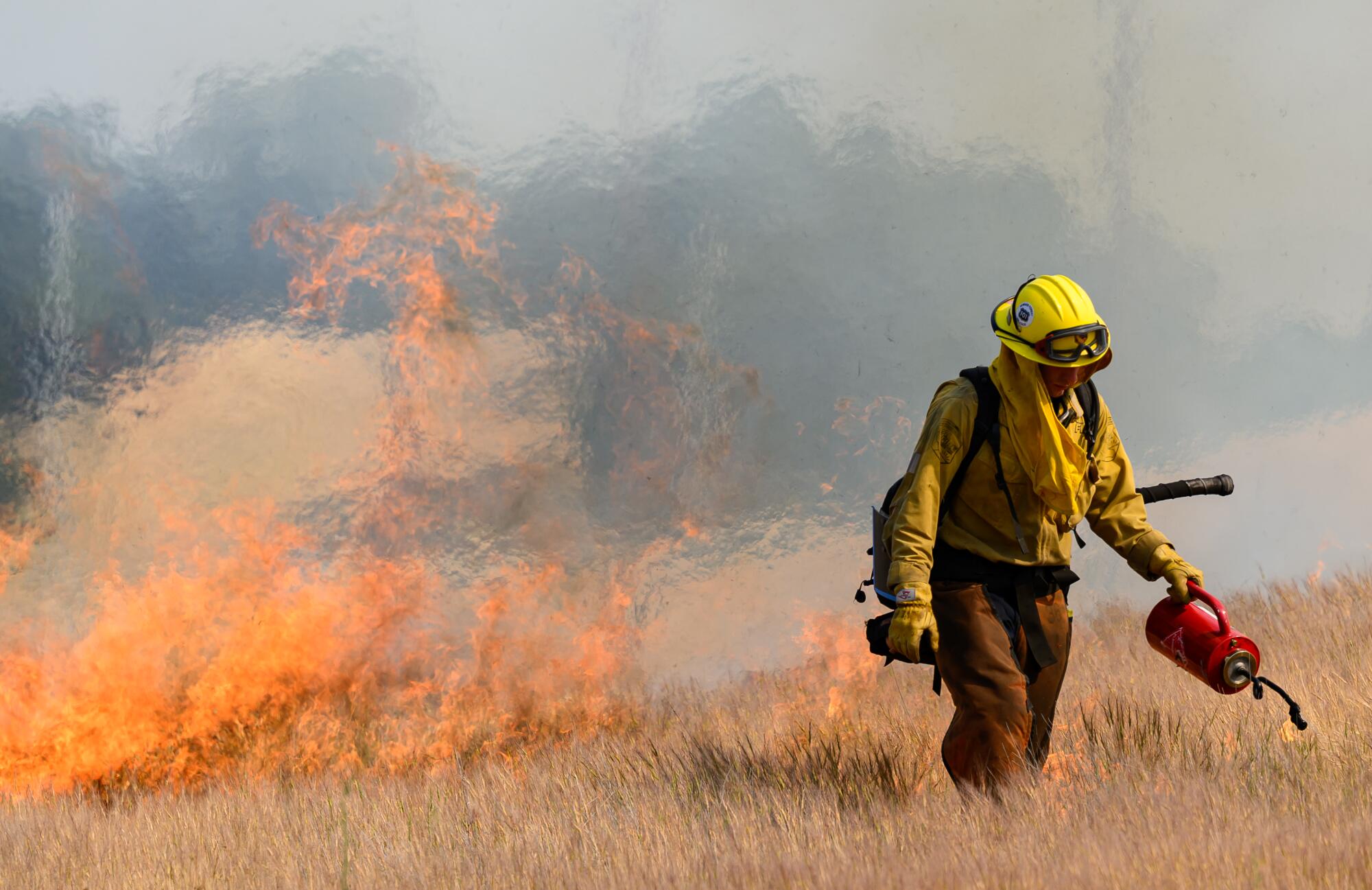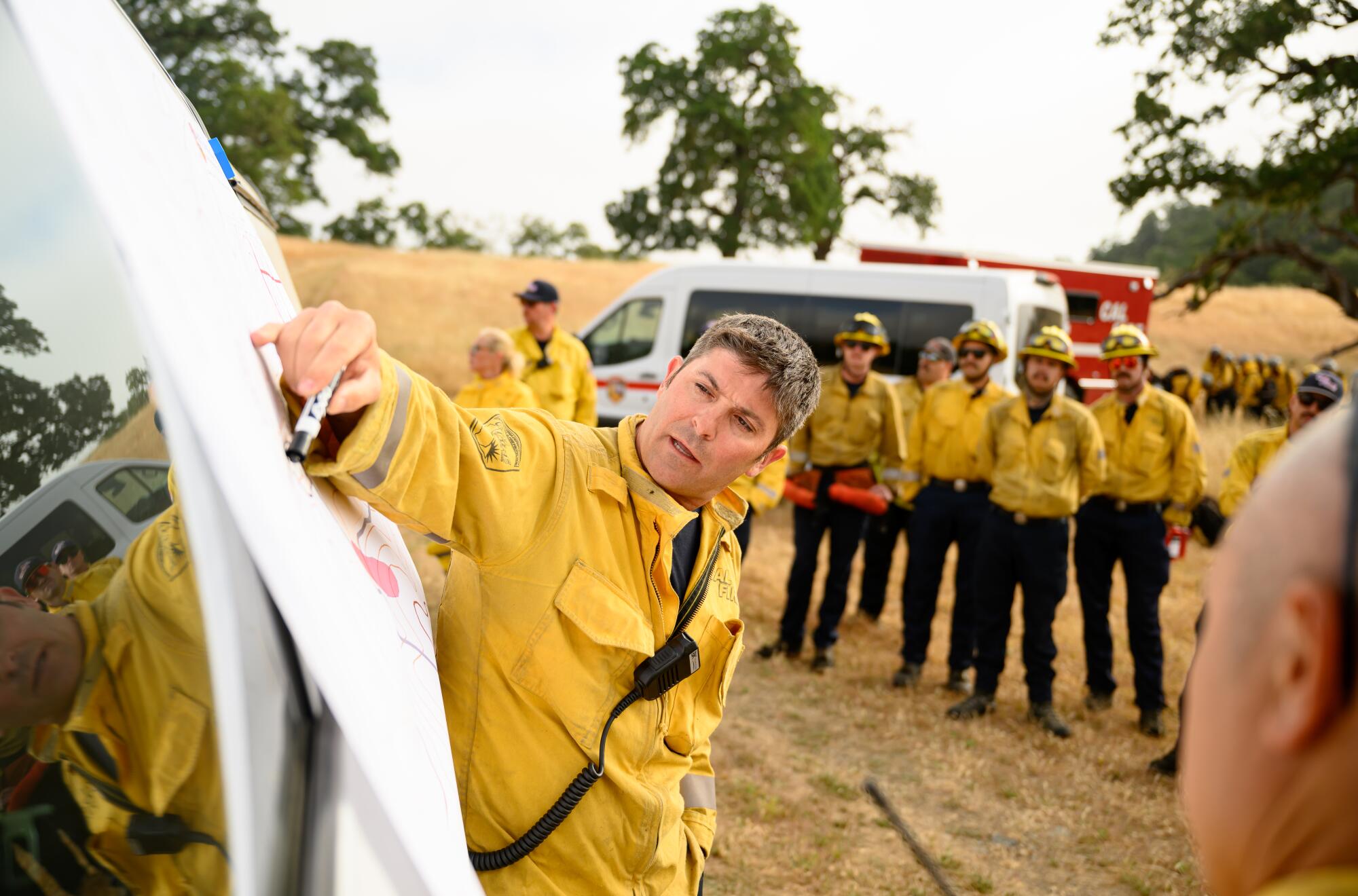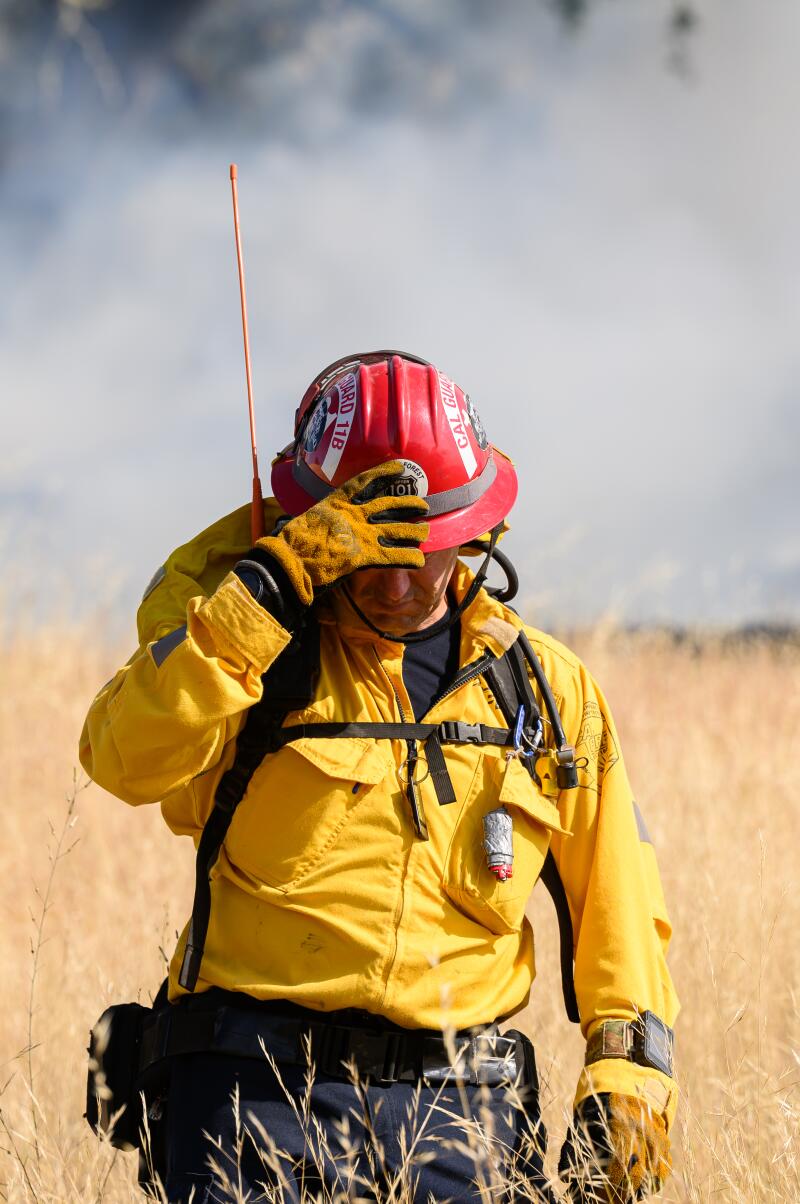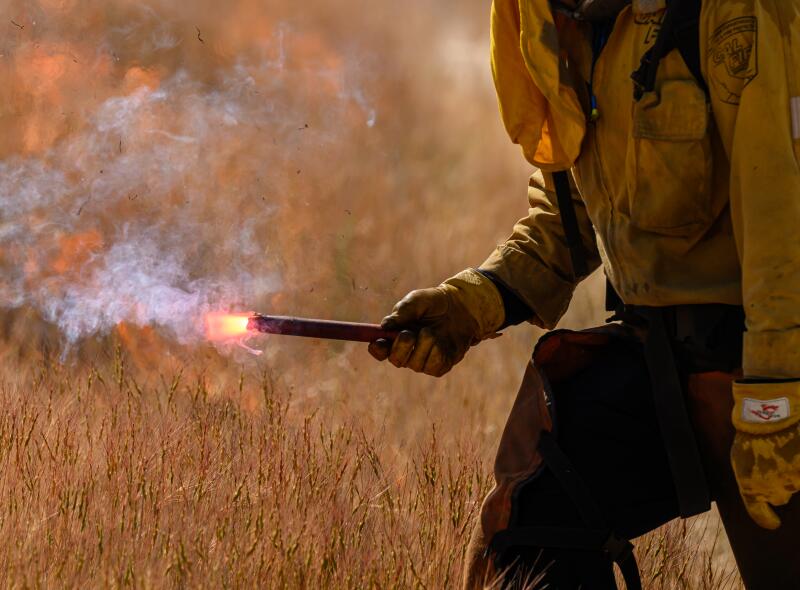HOPLAND, Calif. — On a sun-kissed hillside in distant Northern California, I watched in awe as a crackling fireplace I’d helped ignite engulfed a hillside lined in tall, golden grass. Then the wind shifted barely, and the dense grey smoke that had been billowing harmlessly up the slope turned and engulfed me.
Inside seconds, I used to be blind and coughing. Essentially the most intense warmth I’d ever felt appeared like it could sear the one uncovered pores and skin on my physique: my face. Because the flames inched nearer, to inside a couple of toes, I backed up till I used to be trapped in opposition to a tall fence with nowhere left to go.
Alone in that scenario, I’d have panicked. However I used to be with Len Nielson, chief of prescribed burns for the California Division of Forestry and Hearth Safety, who stayed as cool as the opposite facet of the pillow.
Like a pilot calmly instructing passengers to lock their seat belts, Nielson advised I wrap the fire-resistant “shroud” hanging from my shiny yellow helmet round my face. Then he advised me to take a couple of steps to the left.
And, identical to that, we have been out of the choking smoke and into the light morning daylight. The temperature appeared to have dropped a couple of hundred levels.
“It became uncomfortable, but it was tolerable, right?” Nielson requested with a reassuring grin. “Prescribed fires are a lot about trust.”
Dripping gasoline onto dry grass and intentionally setting it ablaze within the California countryside felt wildly reckless, particularly for somebody whose job entails interviewing survivors of the state’s all too frequent, catastrophic wildfires. However “good fire,” as Nielson referred to as it, is important for lowering the gasoline obtainable for dangerous fireplace, the type that makes the headlines. The precept is as historical as it’s easy.
Earlier than European settlers arrived in California and insisted on suppressing fireplace at each flip, the panorama burned recurrently. Generally lightning ignited the flames; generally it was Indigenous individuals utilizing fireplace as an apparent, and remarkably efficient, instrument to clear undesirable vegetation from their fields. Regardless of the trigger, it was widespread for a lot of the land in California to burn about as soon as a decade.
“So it was relatively calm,” Nielson mentioned, because the flames we’d set danced and swirled just some toes behind him. “There wasn’t this big fuel load, so there wasn’t a chance of it becoming really intense.”
With that in thoughts, the state set an bold purpose within the early 2020s to intentionally burn at the least 400,000 acres of wilderness every year. The vast majority of that must be managed by the federal authorities, since businesses together with the U.S. Forest Service, the Bureau of Land Administration and the Nationwide Park Service personal practically half of the state’s whole land. And so they personal greater than half of the state’s forests.

Cal Hearth crew members set a prescribed burn close to Hopland in Mendocino County.
(Josh Edelson / For The Occasions)
However California officers fear their bold objectives are more likely to be thwarted by deep cuts to these federal businesses by Elon Musk’s budget-whacking White Home advisory workforce, dubbed the Division of Authorities Effectivity, or DOGE. In latest months, the Forest Service has misplaced about 10% of its workforce to mass layoffs and firings. Whereas firefighters have been exempt from the DOGE-ordered staffing cuts, staff who deal with the logistics and clear the myriad regulatory hurdles to safe permission for prescribed burns weren’t.
“To me, it’s an objective fact that these cuts mean California will be less safe from wildfire,” mentioned Wade Crowfoot, California’s secretary of pure assets. He recalled how President Trump, in his first time period, erroneously blamed the state’s wildfires on state officers who, Trump mentioned, had didn’t adequately “rake” the forests.
“Fifty-seven percent of our forests are owned and managed by the federal government,” Crowfoot mentioned. If anyone failed, it was the president, he argued.
Larry Moore, a spokesman for the U.S. Division of Agriculture, which oversees the Forest Service, mentioned the job cuts gained’t have an effect on the company’s fireplace prevention efforts.

Cal Hearth crew members plot out the course and scope of a prescribed burn in Mendocino County.
(Josh Edelson / For The Occasions)
As a result of individuals get fairly testy while you unintentionally smoke out an elementary college or outdated people house, burn plans should clear substantial hurdles introduced by the California Environmental High quality Act and air high quality regulators.
It took three years to get all of the required permissions for the 50-acre Hopland burn in Mendocino County, the place winery homeowners frightened their world-class grapes would possibly get a little bit too “smoky” for many wine lovers. When the massive day lastly arrived in early June, greater than 60 firefighters confirmed up with a number of fireplace engines, at the least one bulldozer and a firefighting helicopter on standby in case something went fallacious.
They gathered on the College of California’s Hopland Analysis and Extension Middle, the place college students find out about ranching and wilderness ecology.
However this was no college challenge. A hearth that started within the surrounding hills a few years in the past threatened to lure individuals within the heart, so the realm being burned was alongside the one two roads that might be used to flee.
“We’re trying to create a buffer to get out, if we need to,” mentioned John Bailey, the middle’s director. “But we’re also trying to create a buffer to prevent wildfire from coming into the center.”



Smoke emanates from a prescribed burn in Mendocino County. (Josh Edelson / For The Occasions)
Because the firefighters pulled on their protecting yellow jackets and pants, and stuffed their drip torches with a mix of diesel and gasoline, Nielson bent down and grabbed a fistful of the yellow grass. Working it by his fingers, he confirmed it to his deputies and so they all shook their heads in disappointment — too moist.
Thick marine-layer clouds stuffed the sky at 7 a.m, conserving the relative humidity too excessive for a superb scorching. In a few years of overlaying wildfires, it was the primary time I had seen firefighters trying bored and disenchanted as a result of nothing would burn.
By 8:45 a.m., the clouds cleared, the solar got here out, and the grass in Nielson’s fist started to crinkle and snap. It was time to go to work.
The hearth that will fill the sky and drift north that afternoon, blanketing the city of Ukiah with the acquainted orange haze of fireplace season, started with a single firefighter strolling alongside the sting of a cleared grime path. As he moved, he made little dots of flame along with his drip torch, drawing a line like a child working the sides of an image in a coloring guide.
Further firefighters labored the opposite edges of the sphere till it was encircled by strips of burned black grass. That means, irrespective of which course the hearth went after they set the middle of the sphere alight, the flames wouldn’t — in most circumstances — escape the comparatively small take a look at patch.
On the uphill fringe of the patch, alongside the highest of a ridge, firefighters in full protecting gear leaned in opposition to a picket fence with their backs to the smoke and flames climbing the hill behind them. They’d all carried out this earlier than, and so they trusted these black strips of pre-burned grass to cease the hearth earlier than it acquired to them.
Their job was to maintain their eyes on the downward slope on the opposite facet of the ridge, which wasn’t imagined to burn. In the event that they noticed any embers drift previous them into the “green” zone, they’d instantly transfer to extinguish these flames.
Nielson and I have been standing alongside the fence, too. Along with the circle of pre-burned grass defending us, we have been on a mud path about 4 toes vast. For somebody with expertise, that was an unlimited buffer. I used to be the one one who even flinched when the smoke and flames got here our means.
Afterward, once I confessed how panicked I had felt, Nielson mentioned it occurs to lots of people the primary time they’re engulfed in smoke. It’s significantly harmful in grass fires, as a result of they transfer so quick. Individuals can get utterly disoriented, run the fallacious means and “get cooked,” he mentioned.

Grass fires are significantly harmful, as a result of they transfer so quick, says Cal Hearth Workers Chief Len Nielson. Individuals can get disoriented within the smoke, run the fallacious means and “get cooked.”
(Josh Edelson / For The Occasions)
However that take a look at patch was simply the warmup act. Nielson and his crew have been checking to verify the hearth would behave the way in which they anticipated — pushed in the suitable course by the light breeze and following the slope uphill.
“If you’re wondering where fire will go and how fast it will move, think of water,” he mentioned. Water barely strikes on flat floor, but it surely picks up velocity when it goes downhill. If it will get right into a steep part, the place the partitions shut in like a funnel, it turns into a waterfall.
“Fire does the same thing, but it’s a gas, so it goes the opposite direction,” Nielson mentioned.
With that and some different pointers — we watched as three guys drew a line of fireplace across the base of a giant, stunning oak tree in the course of the hillside to defend it from what was about to occur — Nielson led me to the underside of the hill and handed me a drip torch.
As soon as everyone was in place, and all the security measures had been put in place, he needed me to assist set the “head fire,” a 6-foot wall of flame that will roar up the hill and devour dozens of acres in a matter of minutes.
“It’s gonna get a little warm right here,” Nielson mentioned, “but it’s gonna get warm for only a second.”
As I leaned in with the torch and set the grass ablaze, the warmth was overwhelming. Whereas everybody else working the hearth appeared nonchalant, I used to be tentative and terrified. My proper hand stretched ahead to make the dots and dashes the place Nielson instructed, however my butt was sticking as far again into the highway because it may get.
I requested Nielson how scorching he thought the flames in entrance of us have been. “I used to know that,” he mentioned with a shrug. “I want to say it’s probably between 800 and 1,200 degrees.”
With the hillside nonetheless burning, I peeled off all the protecting gear, hopped in a automobile and adopted the smoke north alongside the 101 Freeway. By lunchtime, Ukiah, a city of 16,000 that payments itself because the gateway to the redwoods, was shrouded in haze.
Everyone smelled the smoke, however prescribed burns have gotten so widespread within the area, no person appeared alarmed.
“Do it!” mentioned Judy Hyler, as she and two mates walked out of Stan’s Maple Cafe. A veteran of the rampant destruction of wildfires from years previous, she didn’t hesitate when requested how she felt concerning the effort. “I would rather it be prescribed, controlled and managed than what we’ve seen before.”

